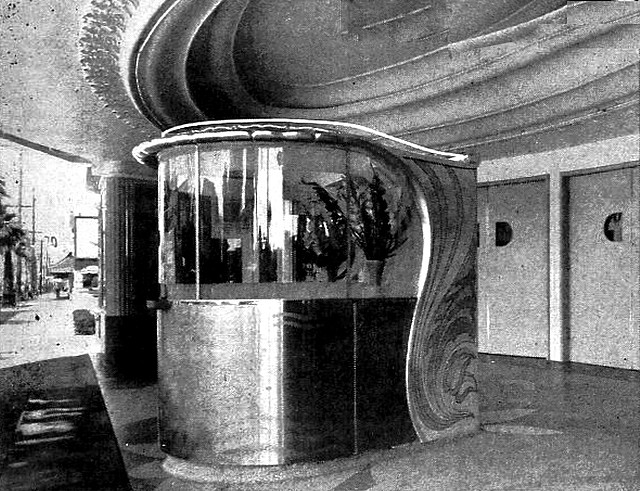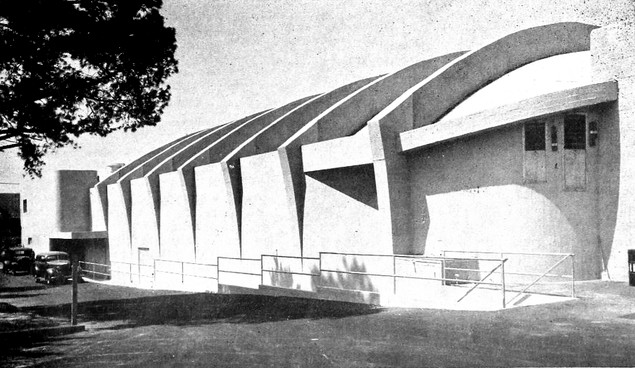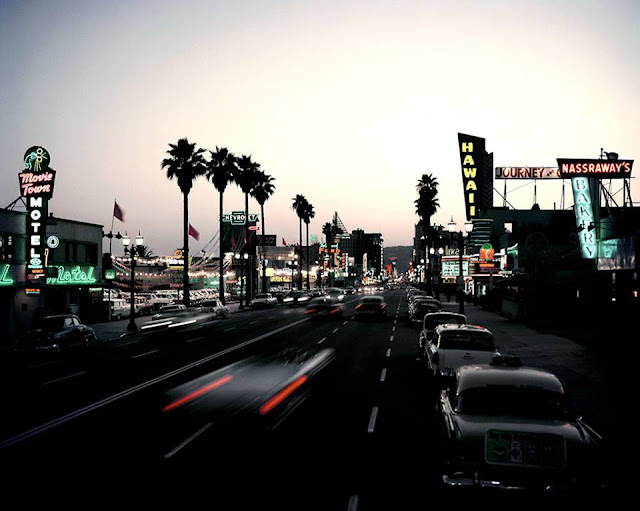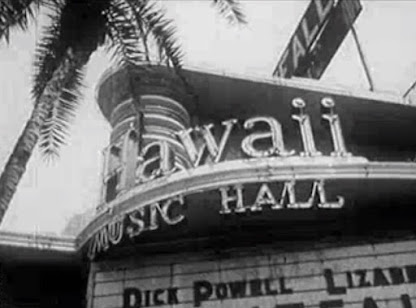Opened: May 6, 1940 with Raymond Massey in "Abe Lincoln in Illinois" along with "The Courageous Dr. Christian" starring Jean Hersholt. Thanks to Noirish Los Angeles contributor Ethereal Reality who spotted the opening night photo on eBay and included it in his Noirish LA post #29400.
Galston and Sutton Theatres was the initial operator. They also were running the nearby Marcal Theatre, a house that later was renamed the World. They were also the operators of the Center Theatre in East L.A. The building the Hawaii was in was owned by the Times-Mirror Co.
A February 18, 1940 L.A. Times article about the theatre's construction. Thanks to Ken McIntyre for finding it for a post on the Photos of Los Angeles private Facebook group.
Michael Moran comments:
"It wasn't 'Hawaiian' in the all-out no holds
barred Chinese or Egyptian sense but it conveyed the general idea. The
volcano erupted and the waterfall fell courtesy of cleverly placed
lights. As a kid, I LOVED this theatre. It always smelled like jujubes,
Necco wafers and Dots and, best of all, it got ALL the really good
movies. Its been gone for more than 50 years, but I still get a twinge
every time I drive by. The Hawaii rocked."
An October 1941 ad for "Citizen Kane." Thanks to Ken McIntyre for locating this for a post on Photos of Los Angeles. Bruce Kimmel notes that this exclusive engagement began October 16. It had premiered at the El Capitan on May 8 with the regular run at the El Capitan and the RKO Hillstreet beginning the next day.
"In person: the stand-ins of the Hollywood Stars." Thanks to Larry Harnisch and his blog The Daily Mirror for the 2012 story "Hellzapoppin Opens in Los Angeles." The article included this ad for the film's 1942 first run engagement at the Hawaii following the moveover run of "Citizen Kane." "Hellzapoppin" was the Hawaii's initial first run film.
In the mid 40s the theatre was known as the Hawaii Music Hall. A group of four theatres was booked as the "4 Music Halls." The others were the Music Hall in Beverly Hills (formerly the Elite), the Hollywood Music Hall (later renamed the Holly Theatre) and the Downtown Music Hall, later back to its original name, the Tower.
Just like Times Square. In 1955 Galston and Sutton added a vertical sign designed and installed by Electrical Products Corp. It was covered in a full page story in the Modern Theatre section of the May 7 issue of Boxoffice. They noted:
Status: It closed in July 1963 and gutted for use by the Salvation Army.
Interior views:
The lobby at the Hawaii. It's a 1940 Julius Shulman photo in the collection of the Getty Research Institute, one in a set of twelve that they index as Shulman's job #Lee-H. Thanks to Noirish Los Angeles contributor Hoss C for finding the photos in the Getty collection. He has a selection of then on his Noirish post #37350. The Los Angeles Public Library also has a version of the photo.
A look at the upstairs lounge. It's a 1940 Julius Shulman photo in the collection of the Getty Research Institute, one in a set of twelve that they index as Shulman's job #Lee-H. The Los Angeles Public Library also has a version of the photo.
The Nursery. It's a 1940 Julius Shulman photo in the collection of the Getty Research Institute.
Another Julius Shulman nursery photo. She's a little big for the playpen, don't you think? It's a 1940 view in the collection of the Getty Research Institute.
A peek into the auditorium. It's a 1940 Julius Shulman photo in the collection of the Getty Research Institute.
The house left wall. It's a 1940 Julius Shulman photo in the collection of the Getty Research Institute.
House left down front. It's a 1940 Julius Shulman photo in the collection of the Getty Research Institute.
"The new Hawaii theatre recently opened by Galston & Sutton Theatres in Hollywood. Seating is in two sections -- a forward and a rear loge section. The forward section is seated with Kroehler chairs having retracting seats; the loge section is seated with Heywood-Wakefield chairs. The aisle form is said to produce a slight stagger effect."
A closer look at the the rear of the auditorium. It's a 1940 Julius Shulman photo in the collection of the Getty Research Institute. Thanks to Noirish Los Angeles contributor Hoss C for finding the photos in the Getty collection. He has a selection of them on his Noirish post #37350.
A 2010 view by Don Solosan of what's left of the front of the auditorium at the Hawaii Theatre. The photo was taken in conjunction with a Los Angeles Theatre Historical Foundation tour and appeared on the LAHTF Facebook page.
A Don Solosan photo of the rear of the auditorium in 2010, appearing on the LAHTF Facebook page. Thanks, Don!
More exterior views:
Martin Pal, in his Noirish Los Angeles post #37385, comments on the display case on the far left: "It says 'Newspaper Raves welcome Hawaii Theatre' and shows clippings (not readable) of newspaper reviews of the theatre itself."
1940 - A look at the Hawaii during the run of "Rebecca" after it had picked up some awards. It was initially an April release. The photo is from the site Hollywood Historic Photos, displaying several thousand images from Marc Wanamaker's Bison Archives.
1941 - A shot of the theatre running "Vivacious Lady" and "Convoy" after they had picked up some Academy Awards. "Vivacious Lady," released in 1938, had played its first run engagement at the Pantages.
Thanks to Ken McIntyre for spotting the photo and posting it on Photos of Los Angeles. It's from Gregory Paul Williams' wonderful 2005 book "The Story of Hollywood, An Illustrated History." It's available on Amazon and there's also a Google Books preview to browse.
1941 - The Hawaii for the moveover run of "Citizen Kane." The first-run engagement had been down the street at the El Capitan -- which, after several more legit bookings, would close for a remodel that would turn it into a film house called the Paramount. Along with renting the El Capitan, RKO put "Kane" into a theatre they owned downtown, the RKO Hillstreet.
1943 - An accident scene photo that's in the Herald Examiner collection at the Los Angeles Public Library. The Hawaii, on the right, was running "Crime Doctor." The photo ran July 17 with this caption: "This photo shows the safety zone where pedestrians were injured by a car. Black line shows path of car, 'X's' mark the spot where the injured pedestrians stood."
1947 - A Burton Frasher postcard view looking west for his Frasher Foto Card series. The photo is from the Frasher collection at the Pomona Public Library and appears on Calisphere.
The Hawaii was running "The Chase" with Robert Cummings and Peter Lorre. The photo also appears in the Bruce Torrence Hollywood Photograph Collection and Mr. Ethereal Reality has it on his Noirish Los Angeles post #29401.
2011 - A look west on Hollywood Blvd. Just to the west is the building that was once the Florentine Gardens nightclub. The theatre marquee just beyond the three palm trees is the X Theatre, demolished in 2016. Photo: Google Maps
The Hawaii Theatre in the Movies:
We get a quick look at the Hawaii in the nine minute AMPAS/RKO 1948 short "Let's Go To The Movies," available on the Internet Archive. See the Theatres In Movies post for shots of other theatres featured in the film.
More information: See the Cinema Treasures page for lots of interesting history. Don't miss J.H. Graham's article "5939-5941 Hollywood Boulevard: The Hawaii Theater" for a fine history of the building along with a great collection of ads.
| back to top | Hollywood Theatres: overview and alphabetical lists | Hollywood Theatres: list by address | Downtown theatres | Westside | Westwood and Brentwood | Along the Coast | [more] Los Angeles movie palaces | L.A. Theatres: main alphabetical list | L.A. Theatres: list by address | theatre history resources | film and theatre tech resources | theatres in movies | LA Theatres on facebook | contact info | welcome and site navigation guide |
















































This theater was actually owned by the Times-Mirror Company. It was leased by Galston and Sutton and the address at that time was 5939 Hollywood Blvd.
ReplyDeleteThanks, Angela! Yes, those addresses slop around a bit. I wasn't aware of the Times-Mirror ownership. Thanks for that data point. I'll get it in the text. Any idea how T-M came to be involved? was this just a random investment for them?
DeleteI love the use of neon.
ReplyDeleteWas this theater associated with howard hughes?
ReplyDeleteNot that I'm aware of. The short-lived Hughes Franklin circuit did have two other Hollywood theatres. They opened the Studio Theatre in 1931, a house much later called the Holly. They also had the Mirror, their name for the the theatre on Vine St. that's now called the Montalban. And, Hughes, as owner of RKO for a while, also had the Pantages and Hillstreet under RKO Theatres management. Let me know if you find additional data.
DeleteI was a member of The Salvation Army which moved into the facility in 1964. I spent many years there.
ReplyDeleteI was too. Spent many good years there. Rusty L
ReplyDelete